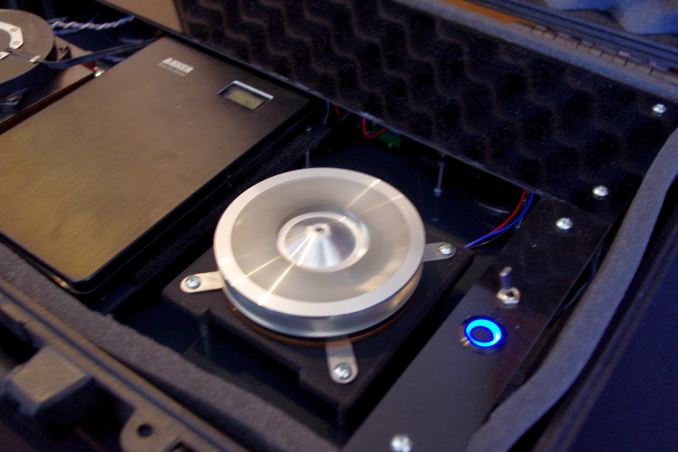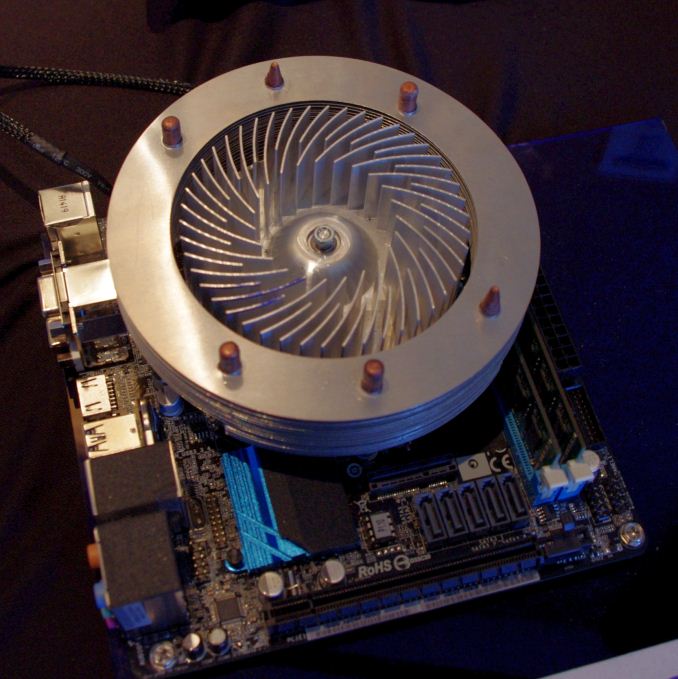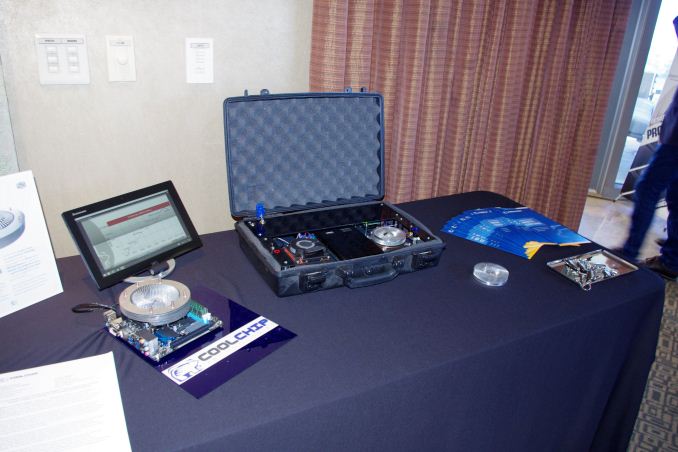New at CES 2015: CoolChip Technologies and Cooler Master Join Forces
by Ian Cutress on January 12, 2015 12:05 PM EST
Even though I follow the air cooling market, I perhaps do not follow it in extreme detail, but a couple of years back we saw a new form of cooling being engineered. It involved, for a lack of a better explanation, a rotating heatsink whereby the air was sucked into the middle and expelled through the fins very quickly in all directions. The base plate connected to the CPU was still present, with the base plate and heatsink separated by a thin (several microns) cushion of air. This air cushion was a concern of mine, as typically conduction through a heatsink as well as the convection of air is usually the limiting cooling factor.
Fast forward two years and a company called CoolChip Technologies (or CoolChip or short) has licensed the latest version of this technology from Sandia Corporation (a subsidiary of Lockheed Martin) and are bringing it to market with the aid of Cooler Master.
I spent some time with the CEO of CoolChip Technologies, Dr William Sanchez, who was on hand to answer questions. At this stage they are still talking with Cooler Master about prototyping, size, market share and vectors of attack when it comes to creating and marketing their designs. As shown above it is more than just a simple rotating central element, and large static heatsinks can be built around it. One particular question I had was about angle of use, as almost all demonstrations of the technology were parallel to the desk. He confirmed that the technology works both upright and upside down, which is good to hear.
The system here, designed to compare a 1U rotating heatsink against a 1U blower, showed that at the same RPM the new design makes less noise and expels air in all directions, helping cool adjacent components. Dr Sanchez remarked that the heatsink was relatively safe to touch, and in true AnandTech style I managed to almost break it when touching it in motion. I postulated that a small frame, similar to a fan guard, might be an easy way to stop prying fingers like mine which might break it.
There is plenty of potential in this technology. The air cooling market has been stagnant for a number of years for something truly revolutionary, at there is potential here for both Coolchip and CoolerMaster to break the age old barrier. If we can get hold of pre-production samples for testing, we will let you know the results. As of yet, due to the early stage of the design, we do not know when that will be.












14 Comments
View All Comments
zodiacfml - Monday, January 12, 2015 - link
Little surface area and little air volume...works as very high speeds though.tghs - Monday, January 12, 2015 - link
Centrifugal fan designs like this are favoured in high resistance applications in HVAC, so could be used with higher density heatsinks with smaller air channels which give more resistance but greater surface area.Jon Tseng - Monday, January 12, 2015 - link
Liquid Metal... Phase Change... Mineral Oil Immersion. There's always a cool new cooling tech out there...But we always seem to end up with good old air and water. Shame really (the mineral oil/fishtank models look particularly appealling, especially now you can get decent passive PSUs and SSDs with no moving parts!).
Zotamedu - Monday, January 12, 2015 - link
Immersion cooling is a horrible idea because serviceability is a huge pain and the actual advantages are very small. Mineral oil is horrible to handle so you will not want to ever change any components in the system. Upgrading a GPU will be a very messy experience and getting the old one clean will be a proper pain. The gain is also not very impressive. You still need a pump for many systems since the oil and the tank itself is not a good enough heatsink. So many people who have tried it have been forced to use a pump and an external radiator anyway. So you end up with something that is less efficient, more expensive and much more of a mess than a regular water loop. It looks cool but is far from practical for the home user. There are some industrial applications though in large scale data centres. You can get a higher power density with liquid cooling and not having to take hot and cold isles and huge amounts of air moving into account when designing the server room is nice.I am looking forward to seeing that cooler in action. It will be very interesting to see how efficient it actually is compared to traditional tower coolers.
ATC9001 - Monday, January 12, 2015 - link
Very true, also, the only thing we really want to focus cooling on is the GPU and CPU. Most other components are fine with just minimal air flow for cooling (more extreme OCing you want to cool power components). So you still need a dedicated cooler for the CPU and GPU, which will likely be water or phase change to a radiator which is cooled by air. So the advantage is gone and you get the fun disadvantages that Zota already mentioned.Antronman - Monday, January 12, 2015 - link
Well phase-change, or water chilling is a fairly expensive solution, and some PC builders just get scared of voiding their warranty for whatever reason. You have to buy an aquarium chiller, get tubing and fittings with the same ID, and a good waterblock. That's ~$500, just for your CPU which is ~$100 away from a custom loop for a GPU and CPU, which just looks way cooler than water chilling.milleron - Monday, January 12, 2015 - link
I realize you haven't been able to test it, but what does the developer CLAIM as to its capabilities?toyotabedzrock - Monday, January 12, 2015 - link
The fan motor looks like it would be a direct contributor to heat on the CPU plate in this design.squngy - Monday, January 12, 2015 - link
>something truly revolutionaryHA
frenchy_2001 - Monday, January 12, 2015 - link
For those that want more information about the principles and execution of this cooler, FrostyTech has been following the development and done a few articles:http://www.frostytech.com/articleview.cfm?articleI...
The main advantage is compactness, as now, the fan IS the heatsink. This is mostly advantageous to the server market or embedded space.